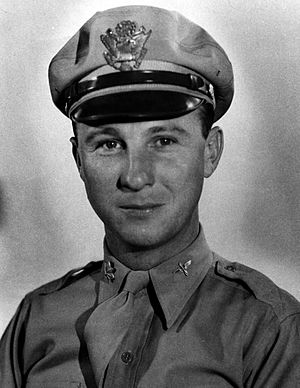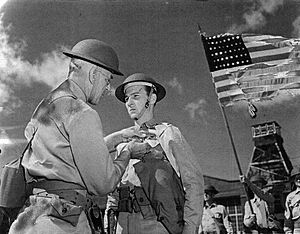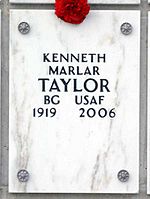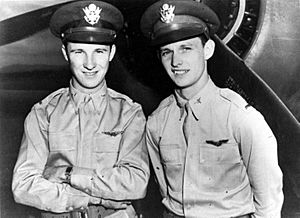Kenneth M. Taylor facts for kids
Quick facts for kids
Kenneth M. Taylor
|
|
|---|---|

Major Kenneth M. Taylor, c. 1945
|
|
| Born | December 23, 1919 Enid, Oklahoma |
| Died | November 25, 2006 (aged 86) Tucson, Arizona |
| Buried | |
| Allegiance | United States |
| Service/ |
United States Army Air Corps United States Army Air Forces United States Air Force Alaska Air National Guard |
| Years of service | 1940–1971 |
| Rank | Brigadier General |
| Unit | 47th Pursuit Squadron 44th Fighter Squadron 12th Pursuit Squadron 4961st Special Weapons Test 456th Fighter Squadron |
| Battles/wars | World War II Cold War |
| Awards | Distinguished Service Cross Army Distinguished Service Medal Legion of Merit Purple Heart Air Medal |
| Other work | Aviation insurance (1971–1985) |
Kenneth Marlar Taylor (born December 23, 1919 – died November 25, 2006) was a brave pilot in the United States Air Force. He was known as a flying ace during World War II. A flying ace is a pilot who has shot down five or more enemy aircraft.
Kenneth Taylor was a young pilot stationed at Wheeler Army Airfield in Hawaii. This was during the surprise Attack on Pearl Harbor by Japan on December 7, 1941. Along with his friend and fellow pilot, George Welch, Taylor managed to get his fighter plane into the air while under attack. He claimed to have shot down four Japanese planes, but only two were officially confirmed. Taylor was hurt during the attack and received several awards for his courage. These included the Distinguished Service Cross and the Purple Heart.
After Pearl Harbor, Taylor led several squadrons in the United States and other places. He served in the military for 27 years. Later, he joined the Alaska Air National Guard until 1971. He then worked in the insurance business before retiring in 1985. His heroic actions at Pearl Harbor were shown in two movies: Tora! Tora! Tora! (1970) and Pearl Harbor (2001).
Contents
Early Life and Military Training
Kenneth Taylor was born in Enid, Oklahoma. Soon after, his family moved to Hominy, Oklahoma. He finished high school there in 1938. That same year, he started studying law at the University of Oklahoma.
Two years later, in 1940, he joined the United States Army Air Corps. He finished his pilot training on April 25, 1941. He became a second lieutenant. In June 1941, he was sent to the 47th Fighter Squadron in Honolulu, Hawaii. He started flying planes there two weeks later. His training plane was the advanced Curtiss P-40B Warhawk fighter. Before the attack on Pearl Harbor, Taylor had already flown over 430 hours.
The Attack on Pearl Harbor
On December 6, 1941, the night before the attack, Taylor was playing poker and dancing. He was at the officers' club at Wheeler Field with his friend, George Welch. They did not go to sleep until 6:30 in the morning. Less than an hour and a half later, at 7:55 a.m., they woke up. They heard low-flying planes, machine-gun fire, and explosions.
Lieutenant Taylor quickly put on his tuxedo pants from the night before. He called Haleiwa Auxiliary Air Field. This is where eighteen P-40B fighters were kept. Without waiting for orders, he told the ground crews to get two P-40s ready for takeoff. The new car he was driving was shot at by Japanese planes. This happened as the two pilots sped the 10 miles (16 km) to Haleiwa. Taylor sometimes drove as fast as 100 miles per hour (160 km/h).
At the airstrip, they quickly got into their Curtiss P-40B Warhawk fighters. The planes had fuel, but only had .30 caliber machine gun bullets.
First Fight
After taking off, they flew towards Barber's Point. This is at the southwest tip of Oahu. They first saw unarmed American B-17 Flying Fortress bombers arriving from the mainland. Soon, they reached Ewa Mooring Mast Field. At least 12 Aichi D3A "Val" dive bombers were attacking it. These were part of the second Japanese attack wave.
Even though the two pilots were outnumbered six to one, they immediately started shooting. Taylor shot down two dive bombers. He also damaged another one. When both pilots ran out of bullets, they flew to Wheeler Field. They needed to get bigger .50 caliber bullets, as Haleiwa did not have any. As Taylor landed around 8:40 a.m., he had to avoid friendly anti-aircraft fire. Once on the ground, officers told Taylor and Welch to leave their planes. But the two pilots convinced them to let them keep fighting.
While Taylor's plane was being reloaded, more dive bombers started attacking Wheeler. Welch took off again because his plane was already reloaded. The ground crew loading Taylor's plane left the ammunition boxes on his wing. They scattered to get away from the bombers. Taylor quickly took off, jumping over equipment. The ammunition boxes fell off his plane's wing.
Both pilots realized that if they flew away from the incoming planes, they would be easy targets. So, they flew directly towards the bombers as they took off. The low-flying Japanese bombers would risk crashing if they tried to shoot at the P-40s on the ground. Taylor used this to his advantage. He started firing at the Japanese planes as he took off. He then performed a special flying move called a chandelle.
Second Fight and Injuries
Taylor flew towards a group of Japanese planes. Because of clouds and smoke, he accidentally flew into the middle of seven or eight A6M Zeros. A Japanese gunner from a dive bomber shot at Taylor's plane. One bullet came very close to his head and exploded in the cockpit. A piece of shrapnel went through his left arm and into his leg.
In a 2001 interview, Taylor said about his injuries, "It was of no consequence; it just scared the hell out of me for a minute." Years later, his crew chief gave him two more bullets found behind his seat. Welch shot down the dive bomber that had hurt Taylor. Taylor damaged another plane before flying away to help Welch with a pursuing A6M Zero fighter. The Zero and its group soon broke off and returned to their ships.
Taylor kept firing at Japanese planes until he ran out of bullets. Both pilots then flew back to Haleiwa. After landing and driving back to Wheeler, they saw their squadron commander. He noticed they were still in their tuxedo clothes. Not knowing about their dogfights, he yelled, "Get back to Haleiwa! You know there's a war on?" The pilots explained what they had done, and the commander thanked them. In 2003, Taylor said about his actions: "I wasn't in the least bit terrified... I was too young and too stupid to realize that I was in a lot of danger."
Records and Awards

The Tropic Lightning Museum states that 14 American pilots took off during the attack. They shot down 10 Japanese planes. Air Corps records officially credit Welch with four kills and Taylor with two. However, new research of Japanese combat reports confirms Taylor shot down four planes, including the two he probably killed. Taylor said in an interview, "I know for certain I shot down two planes or perhaps more; I don't know."
On the 13th anniversary of the attack, the U.S. Air Force said they could not tell which pilot shot down the first Japanese bomber. They said, "Each of them in his first attack shot down an enemy bomber, so the difference in time would have been but a few seconds." During the fight, the two pilots agreed that whoever survived would claim the first kill. Both survived, and because Welch was a higher rank, he was credited with the first kill.
The pilots' actions helped save the Haleiwa airfield from being destroyed. Japanese intelligence did not know about this airfield before the attack. Taylor later said, "I believed I was a better-trained pilot than the enemy. I had good equipment, and I was proud of it."
For their actions on December 7, the U.S. War Department called Taylor and Welch the first two American heroes of World War II. They both received the Distinguished Service Cross on January 8, 1942. This award is the U.S. Army's second highest honor for bravery in battle. Taylor also received the Distinguished Service Medal, the Legion of Merit, the Air Medal, and a Purple Heart for his injuries. Both men were suggested for the Medal of Honor, but they did not receive it because they had taken off without direct orders.
Military Service After Pearl Harbor

After the Pearl Harbor attack, Taylor was sent to the 44th Fighter Squadron. He went to Henderson Field on Guadalcanal in the South Pacific. He shot down two more enemy planes there. One was on January 27, 1943, and the other on December 7, 1943. This brought his total number of career kills to six, making him a flying ace. Officially, Taylor is credited with two kills on December 7, 1941, and one on January 27, 1943.
At Guadalcanal, he was hurt during an air raid. He was sent back to the United States in 1943. In the U.S., he trained pilots for combat in Europe. He was then assigned to the 12th Fighter Squadron. By the end of World War II, Taylor had become a major. He went to the Philippines to lead a squadron that used the first U.S. Air Force combat jets, the Lockheed F-80 Shooting Star.
Later, he led the 4961st Special Weapons Test Group. He also worked as a tactical evaluator and at The Pentagon. He was also a Deputy Chief of Staff for the Alaskan Air Command. He helped plan long-term strategies for the military.
After 27 years of active duty, he retired as a colonel in the U.S. Air Force in 1967. Soon after, he became the Assistant Adjutant General for the Alaska Air National Guard. He retired from this role as a brigadier general in 1971. Taylor then worked in the insurance business in Alaska until 1985.
Awards and Decorations
Here are some of the awards and decorations Kenneth Taylor received:
 |
Command pilot badge |
| Distinguished Service Cross | |
| Distinguished Service Medal | |
| Legion of Merit | |
| Purple Heart | |
| Air Medal | |
| Joint Service Commendation Medal | |
| Air Force Outstanding Unit Award | |
| American Defense Service Medal with one service star | |
| American Campaign Medal | |
| Asiatic-Pacific Campaign Medal with two bronze star | |
| World War II Victory Medal | |
| Army of Occupation Medal | |
| National Defense Service Medal with one bronze star | |
| Air Force Longevity Service Award with one silver oak leaf cluster | |
| Philippine Independence Medal |
Personal Life and Movies
On May 9, 1942, Taylor married Flora Love Morrison. They had met when she was visiting her father in Hawaii. They were married for 64 years. The Taylors had two children, Jo Kristina "Tina" Hartley and Kenneth Marlar Taylor, Jr. They also had three grandchildren and two great-grandchildren. When he lived in Anchorage, Taylor would visit Hawaii every year for vacation.
Taylor's son, Kenneth Marlar Taylor, Jr. (born 1943), also became a brigadier general. He retired in 1997 after 31 years of service. He commanded the Alaska Air National Guard, just like his father.
At a 50th anniversary event for the Pearl Harbor attack, Taylor met a Japanese pilot. This pilot was part of the first wave of bombers to attack Pearl Harbor. The pilot was impressed by Taylor's bravery. Taylor told a reporter, "I have no hatred against Japanese people, but I do against those who started the war."
Taylor helped as a technical adviser for the 1970 film Tora! Tora! Tora!. In this movie, he was played by Carl Reindel. The 2001 film Pearl Harbor showed a scene where characters flew planes to fight the Japanese. This scene was inspired by Taylor's and Welch's actions. However, the characters in the movie were not exactly like Taylor and Welch. Unlike Tora! Tora! Tora!, Taylor was not asked for his advice on the Pearl Harbor film. He later called the movie "...a piece of trash...over-sensationalized and distorted."
Death

Kenneth Taylor passed away on November 25, 2006. He died from a health issue at an assisted living home in Tucson, Arizona. His son said that his father wanted "to be remembered mostly as a good father, husband, grandfather and great-grandfather. He was very loyal and dutiful, and to him that was more important than what he did in the war."
He was cremated, and his ashes were buried at the Arlington National Cemetery in June 2007. He received full military honors. Alaska Senator Ted Stevens gave a speech about him before the service at Arlington.



